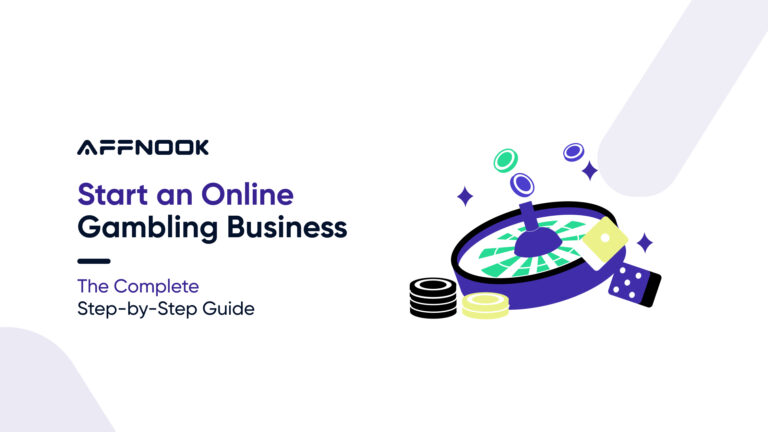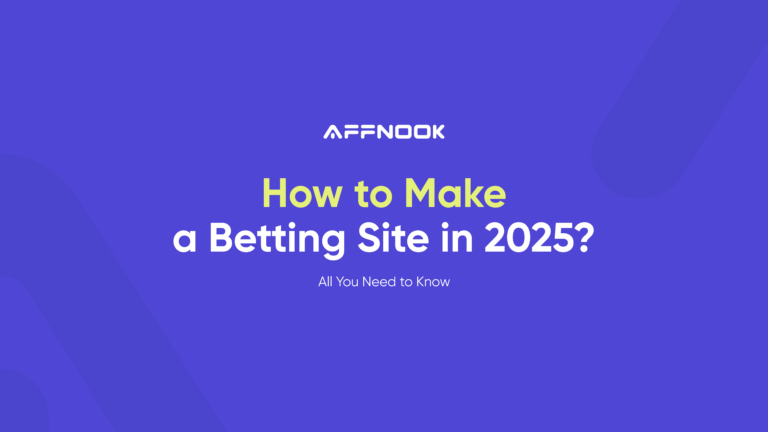The problem with free advice is that it is often incomplete.
As an iGaming business operator or brand, there is no way you haven’t heard this one yet: make your online gaming website responsive.
But what does it really mean?
Is the goal to optimize for the growing mobile or smartphone-based gambling market (reportedly over 80% access iGames in such a fashion). Or, should you be a desktop-ready player, serving the older generation of betters and gamblers, who have now gone digital?
The conundrum is mighty. And so is the challenge — responsiveness doesn’t come easy. Whether it is for mobile or desktop, the effort can be substantial and consistent because this isn’t a one-day win.
So when you’re setting up your online gambling business, and you’re figuring out the logistics of how to make it all happen, this article will give you the answer. In the process of contemplating how to make an online gambling site, find out where responsiveness comes in, and why it matters.
Why is Responsiveness Crucial in the Online Gambling Business?
It essentially connotes fluidity. What is made once for any format flexibly gets reordered and reshaped when it is viewed on any other screen size.
If you’ve built your website on a 13 inch laptop, it should still easily conform to the limited pixels and size of a tablet or smartphone, and vice versa. This means everything, from layout to image sizes and content will stretch, shrink or reorganize to fit into less or more space.
And all this happens seamlessly — without any visible breaks or discontinuity in structure.
Some people call it the advent of the “post-PC” world, i.e. the major source of traffic as we continue into the future, will be mobile and tablet. Proponents of this thought often refer to the concept of the “One Web” approach.
In the larger scheme of how to make an online gambling site, this simply implies that the same services and information should be available to everyone, irrespective of the device they’re on. In this conception of equality, the norms dictate that:
- Your site is not only built for the smallest and largest screens of today, but includes parameters covering unknown screen sizes of the future.
Understanding Responsive and Mobile-first Design
Would you be surprised to know that StatsCounter found 63.2% of the world’s traffic coming from mobile, while 35% was brought by desktop in 2025?
Yet, it is certain that deeper interactions, especially on more complex platforms (such as stats-based, live parlay betting) usually happens on desktop. Therefore, it is clear that responsiveness is not a small screen-only feature, but rather a holistic approach.
So how do ‘responsive’ and ‘mobile-first’ designs differ?
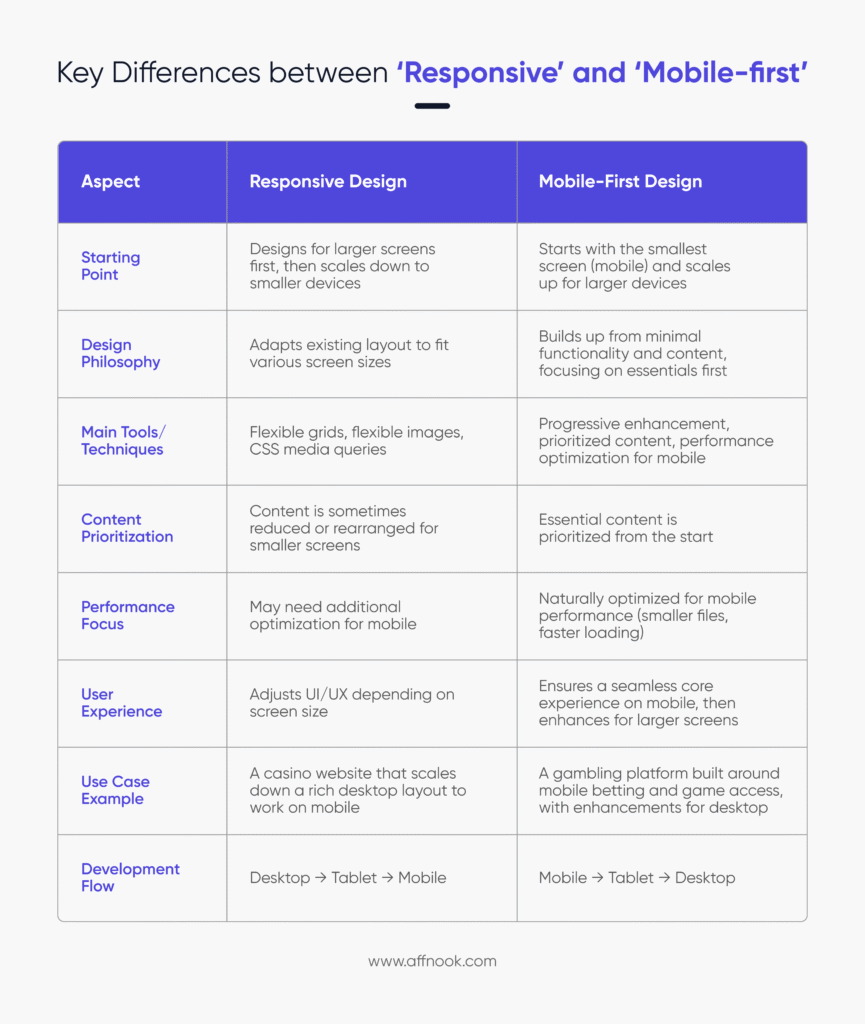
In the case of iGaming, it is crucial to understand what you’re building before you finalize your approach. Before you consider how to make an online gambling site, consider ‘who’ you’re building for: a desktop-reliant gambler, or a mobile-only player? Or, is it both?
If it is both, then leveraging responsiveness even early is the right decision.
Benefits of Making Your Online Gambling Website Responsive
Understanding and implementing website responsiveness in iGaming is just as important as the betting site software you’re using. Poor choices in both areas will affect experience.
A better way to look at it is in terms of the SEO-related benefits. After all, responsiveness in website design is critical to good technical SEO. Here’s how it makes a difference:
- Better Engagement Numbers: When all elements on the page load at once, within a few seconds, users have more incentive to stay due to a top-notch experience.
- Lower Bounce Rates: Following from the previous outcome, when users appreciate the experience, they are less likely to leave quickly.
- Higher Average Session Durations: As a result, each session is going to be longer in time and quality.
- Higher Number of Pages Navigated per Session: Drawing from the previous results, it is obvious that longer and better sessions indicate more pages will get explored each time a user lands on your online gambling site. When you’re working on how to make an online gambling site, figuring out website architecture is crucial to improve navigability for the end user.
- Better Page Ranks: Search engines are known to lean towards mobile-optimized sites. This means if you’re getting this aspect right, your page ranks will automatically reflect better performance.
Studies show 57% users drop off a website if it takes longer than 3 seconds to load on mobile. That’s a small margin — and the true margin of error between putting in a world of effort for user acquisition, only to lose them at the last step.
There are other advantages to the proposition of responsiveness too. A responsive iGaming website compounds on other good practices in the race to rank on SERPs.
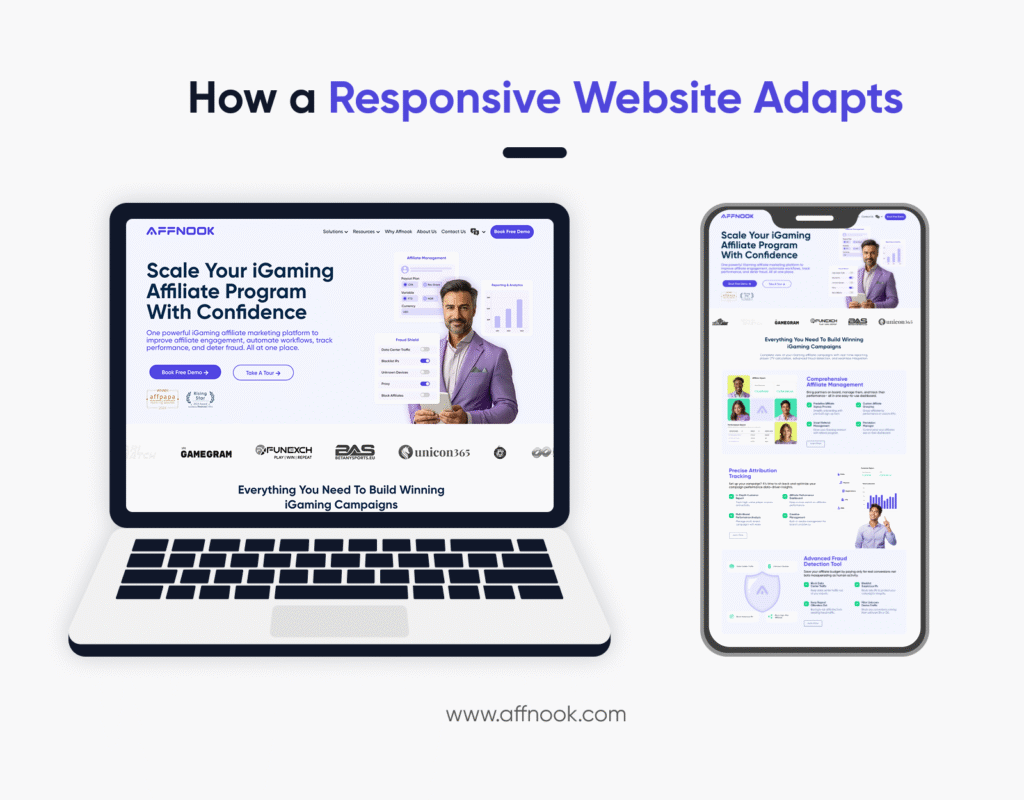
Moreover, having single pages built for each idea or website panel is better than creating duplicate content across the website — a collection of two-page bundles, each one struggling to rank.
Features of Responsive Design
Core design principles are the underlying building blocks of responsiveness — a key checklist of factors that should be referred to when you’re contemplating on how to make an online gambling site.
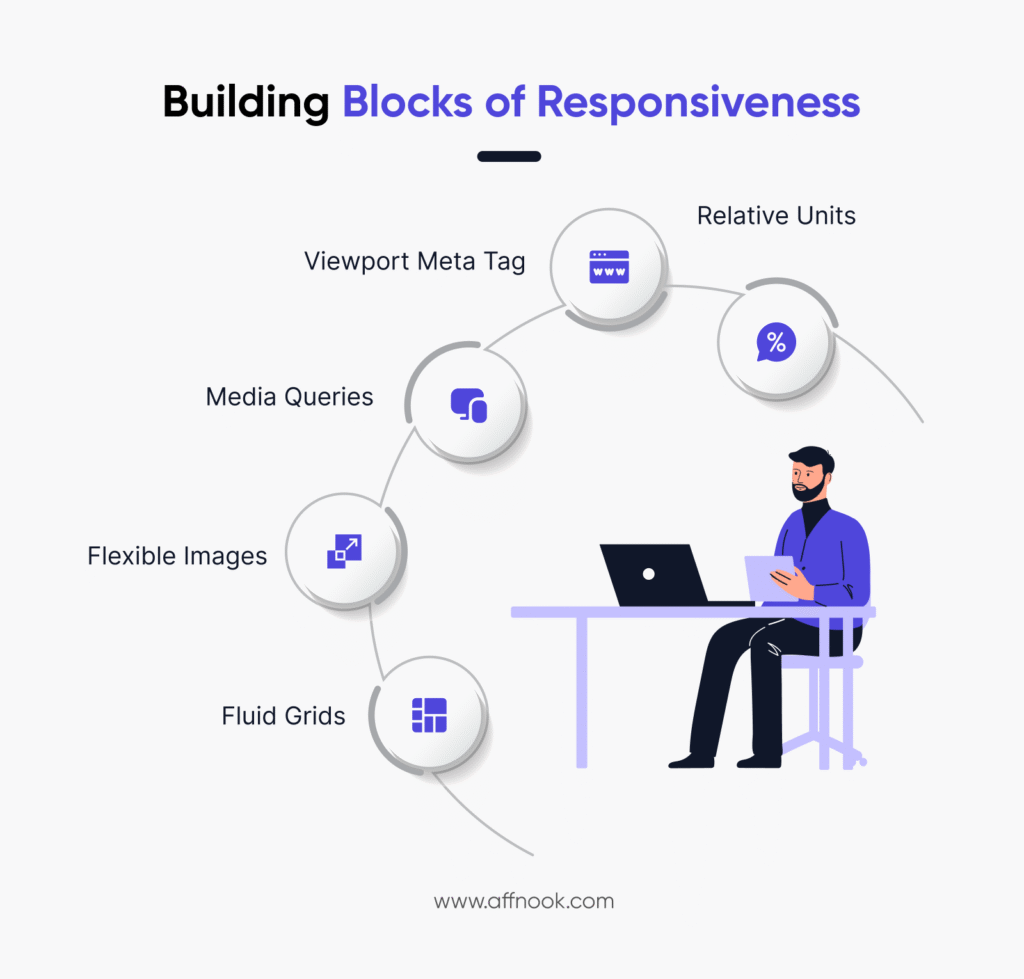
They offer up three hard-to-resist gains: top-tier performance, superb adaptability and exceptional user experience.
1. Flexible Images and Media
Ask anyone who works with websites and they’ll tell you: images and creative elements are usually the hardest to make flexible.
They’re heavy. They’re built in specific sizes. They’re hard to maneuver when the screen size changes by a lot.
Such a problem is solved through the use of containers on the page. They hold down the design or video and manage the scaling. This is an easy problem to solve through the use of CSS code on your online gambling website.
2. Fluid Grids
Time to get rid of fixed-pixel layouts. Instead of using fixed 1:1 relations, fluid grids define elements in the form of percentages. This allows each item to shrink or stretch — proportionally — based simply on viewport sizes.
In the case of an iGaming website, this situation would be presented as such: betting slips and promotional banners get rearranged dynamically, accommodate for width. This limits endless vertical scrolling and strange looking overflows on smaller screens.
3. Media Queries
You can define operations based on the screen size through commands held within the code of the page. When you’re navigating the process of how to make an online gambling site, decisions like screen height, width, orientation and resolution are par for the course. That’s also where you’ll decide the ‘breakpoints’ for the page.
Here, media queries affect layout changes through the breakpoints you establish beforehand.
Let’s understand this better through an example.
Suppose you have a layout with a single column on a desktop. This column will split and become two columns on a tablet screen. On smaller smartphone screens, this may split further into three, accommodating for length through width.
4. Typography
Text is the most important element to get right on while creating your betting site or gambling platform webpages. If it is hard-to-read or too large with respect to the page it is on, the entire formatting of the page gets affected. Not only does it lead to a poor user experience, it is probably going to get them to click off the page.
That’s why text can be kept flexible through the use of relative units like “em” or “rem”. It manages everything from font sizes to line spacing and line height.
5. Mobile-first Development Approach
It’s simple: if you develop your site keeping in mind the smallest screen first, the form and functional arrangement for other sizes is easier to account for.
As a result, a baseline is set for the most restrictive format, and the process of how to make an online gambling site for other sizes can be expedited. All it takes is spreading all the elements out, or conforming for more space — a better problem to have, than needing to fit lots of items into a tiny screen.
6. Touch Targets or Interactive Elements
On mobile and tablet interfaces users have to navigate through ‘touch’. This also means there is the hazard of clicking off on unintended items, and getting navigated off the very page they still wanted to be on. That’s not how you want a user’s experience to go.
By planning your links and buttons well, and ensuring the ‘clickable’ zones are separate and visible compared to the area without them, is a key to achieving equilibrium in this aspect.
Navigation menus too must be considered when planning an accidental-tap free zone. Collapsed navigation or “hamburger” menus are one way to achieve this. Ensure buttons are at least 48×48 pixels in size, with limited calls-to-action placed together.
What are the Technical Challenges?
There is no end to how good it could potentially get. But the real challenge with thinking on how to make an online gambling site — as with all good things — begins at implementation. Let’s understand where the biggest roadblocks lie and how you, as an operator or brand, can overcome them.
1. Page Load Time
Creating a highly responsive website can create the issue of increasing loading times. If assets for too many screen types are already included, the website is bound to be heavy.
What’s more? There’s going to be the additional HTTPs requests and issues of inefficient server responses.
What’s the fix?
- Image Optimization: Think lazy loading, WebP formats and ‘srcset’ images.
- Caching: Let returning visitors get everything even faster the second time around.
- Content Delivery Networks (CDNs): If they’re located in the right places, the loafing takes no time at all.
- Conditional Loading: Decide whether you want certain graphics or media elements to be visible at all for certain devices or not.
2. Complex Navigation Adaptation
Maximal account types and numerous games on your iGaming platform are certainly not meant to be stuffed into smaller screens. These types of websites are a standard in iGaming — and they’re necessary too. Poor touch targets can become a recurrent challenge.
How can this be solved?
- Off-canvas Navigation: It shows up when you need it. Otherwise, it simply exists as a folded up icon, to be expanded in times of need.
- Prioritization: Identify what’s more essential and place it more prominently.
- Add a Search Function: Instead of filling up the screen with items, let interested users search for what they need.
3. Managing Rich Media
Streaming windows, live odds, commentary on parlays, gamification features and animated banners are standard elements on most well-created, dynamic websites. In contemplating how to make an online gambling site, responsiveness can make you compromise on such feature-rich pages — that quite frankly are people pullers.
So what’s the solution?
- Scalable Vector Graphics (SVGs): Use them for icons and logos so there is no loss of quality when stretching or shrinking.
- Choose CSS over JavaScript: Choose simpler implementations over technical, hard-to-follow techniques.
- Simplify Content: Try to limit tables to 3 columns or less and reduce the use of features that can cause content to look odd on mobile view, such as indents and too many differing heading tags.
4. Cross-browser and Device Compatibility
Edge, Firefox, Safari and Chrome weren’t all created equal — but users using them certainly shouldn’t be treated any differently. iPhones, Androids, pixel sizes and screen resolutions further skew visuals.
How can you create a one-size-fits-all?
- Polyfills: Bring out functionalities that older browsers don’t support natively.
- Thorough Testing: See how things look on real browsers and emulators before you make them live.
- Attempt Cloud-based Testing: Get access to a wider range of devices and browsers.
- Enhance Progressively: Don’t do it all at once. Build a baseline experience that works for everyone, everywhere. Then stack more items onto it, and test as you go.
Summing Up
Statistics show (and player behaviours demonstrate) how responsiveness can be a crucial step towards achieving more engagement. Lack of it can be a hindrance to your overall business goals and revenue targets.
When you’re solving the problem of how to make an online gambling site, it is vital to think about responsiveness, and plan for features that make it possible. While technical challenges such as long load times and managing media-rich elements remain, there are practical ways to overcome them.
User experience is a simple, yet often underestimated element in overall player satisfaction — and more critically, retention. But it would be a fool’s errand to create a website that doesn’t factor in technical SEO and a variety of screen sizes.
Accessibility is one thing. But a seamless experience and true enjoyability are what any online gambling business should be after.
Help Section
1. What is the first step in learning how to make an online gambling site?
The first step in how to make an online gambling site is defining your business model and selecting the right software provider. You’ll need to decide the type of gambling platform you want to launch — casino, sportsbook, or hybrid — and ensure that your chosen provider offers licensing support, security features, and responsive web design capabilities.
2. Why is website responsiveness important when figuring out how to make an online gambling site?
When planning how to make an online gambling site, responsiveness is crucial because most users access gambling platforms via mobile devices. A responsive design ensures your site automatically adapts to different screen sizes, improves loading speed, enhances user experience, and helps your platform rank higher in search engines.
3. Do I need separate designs for mobile and desktop when learning how to make an online gambling site?
Not necessarily. A major part of how to make an online gambling site involves using responsive design principles so that a single layout can adjust across multiple devices. This approach saves development costs, keeps your brand identity consistent, and ensures all players — mobile or desktop — get a seamless experience.
4. What technical challenges should I expect when understanding how to make an online gambling site?
While exploring how to make an online gambling site, you’ll likely face challenges like optimizing page load speed, ensuring cross-browser compatibility, managing rich media such as live streams, and creating touch-friendly navigation for mobile users. Overcoming these requires smart design choices, testing tools, and regular optimization.
5. How does responsive design affect SEO when planning how to make an online gambling site?
Search engines like Google prioritize mobile-friendly websites, making responsiveness a critical part of how to make an online gambling site that ranks well. A responsive layout improves engagement, reduces bounce rates, and boosts page performance — all key factors in achieving higher visibility on search engine results pages (SERPs).

